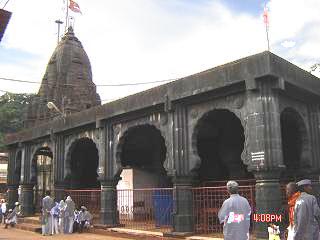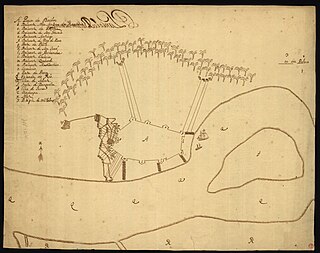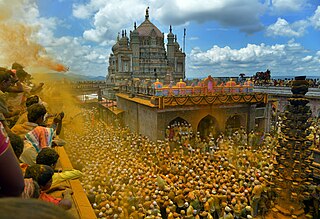
Bajirao I, born as Visaji, was the 7th Peshwa of the Maratha Confederacy.

Shaniwar Wada is a historical fortification in the city of Pune, India.

The BhimashankarMandir is a Shiva mandir situated in its eponymous village, Bhimashankar, in Pune district of Maharashtra. It is a key pilgrimage centre and one of the 12 Jyotirlinga in the world. The temple's Shiva lingam is one of the three Jyotirlinga of Maharashtra. The mandir is situated on a mountain. It is 110 kilometers away from Pune. The temple's vicinity has rare plant and animal species. The mandir is located in Khed taluka, in the Bhimashankar forest range.

Balaji Baji Rao, often referred to as Nana Saheb I, was the 8th Peshwa of the Maratha Confederacy. He was appointed as Peshwa in 1740 upon the death of his father, the Peshwa Bajirao I.

Narayanrao was the 10th Peshwa of the Maratha Confederacy from November 1772 until his assassination in August 1773. He married Gangabai Sathe who later gave birth to Sawai Madhavrao.

Nana Fadnavis, born Balaji Janardan Bhanu, was a Maratha minister and statesman during the Peshwa administration in Pune, India. James Grant Duff states that he was called "the Maratha Machiavelli" by the Europeans.
Wai is a town in Satara district of Maharashtra state in India. Located on the Krishna River, Wai was a prominent town during the Peshwa era. Two important Marathi Brahmin from ruling families had their origins here: Rani Lakshmibai of Jhansi and Gopikabai, wife of Nanasaheb Peshwa.

The Battle of Vasai or the Battle of Bassein was fought between the Marathas and the Portuguese rulers of Vasai, a town near Mumbai (Bombay) in the Konkan region of the present-day state of Maharashtra, India. The Marathas were led by Chimaji Appa, a brother of Peshwa Baji Rao I.

Raghunathrao Bhat, also known as Ragho Ballal or Raghoba Dada, was the younger son of Peshwa Bajirao I who served as the 11th Peshwa of the Maratha Empire for a brief period from 1773 to 1774. He succeeded his Nephew Narayanrao.

Arnala Fort is built on a small island off the port town of Arnala, located around 13 km north of Bassein, Maharashtra, India. Being an island fort, it is also called Jaldurg or Janjire-Arnala. The Marathas who build the present fort called it Janjire Arnala.

Chimaji Balaji Bhat (1707–1740), commonly referred to as Appa or Bhau, was the son of Balaji Vishwanath Bhat and the younger brother of Bajirao Peshwa of Maratha Empire. The high watermark of his career was the capture of Vasai fort from the Portuguese.

Jejuri is a city and a municipal council in the Pune district of Maharashtra, India. Khandoba Mandir is an important Hindu temple to the Hindu Lord Khandoba, one of the most visited tirtha in Maharashtra.
Sarasgad fort is situated near village Pali in the Raigad district of Maharashtra. Pali lies about 10 kilometres East of Nagothane along the Nagothane-Khopoli road. This fort height from sea level is 490 meters

Samvedis or Samvedi Brahmins are an Indian Hindu Brahmin community, originating from a group of classical musicians and classical dancers. They follow Sama Veda and believed to have been originated from Odisha, India.

Dhom Dam is an earthfill and gravity dam on Krishna River near Wai in state of Maharashtra in India.
Kashibai was the first wife of Bajirao I, the Peshwa to the fourth Maratha Chhatrapati (Emperor) Shahu. With Bajirao, she had four children, including Balaji Baji Rao and Ragunath Rao. Balaji succeeded Bajirao as Peshwa upon the latter's death in 1740. Also following Bajirao's death, Kashibai fostered her step-son, Shamsher Bahadur, whose mother was Bajirao's second wife, Mastani.
The Bhat Peshwa family earlier known as Bhat family is a prominent Indian Chitpavan Brahmin family who dominated India for around 100 years in the late 18th century and early 19th century. Most of the members in this family were the Peshwas in the Peshwa Era of the Maratha Empire, and Peshwa later became their family name. During their regime, most of the Indian subcontinent was under their control. The last Peshwa, Baji Rao II, was defeated by the British East India Company in the Third Anglo-Maratha War in 1818. The territory was annexed to the British East India Company's Bombay Presidency, and he was pensioned.

Shri Laxmi Narsimha Temple is a Hindu temple dedicated to Narasimha, an avatar of Vishnu, located in western India, in Pune district of the state of Maharashtra. The temple is located at the confluence of Bhima river and Nira river, at the south eastern tip of Pune district, in Indapur taluka.

The Khandoba Temple of Jejuri is a Hindu temple dedicated to the god Khandoba, located on a hill in the town of Jejuri, Maharashtra, India. It is one of the most prominent Hindu pilgrimage centres of Maharashtra.

Kashibai Bajirao Ballal is an Indian historical drama based on Kashibai. It premiered on 15 November 2021 on Zee TV with Aarohi Patel as Young Kashi Bai and Venkatesh Pandey as Young Bajirao. On 21 March 2022, the story moved on several years and Riya Sharma portrays the lead role of Kashibai opposite Rohit Chandel who essays the role of Bajirao. It went off air on 19 August 2022, after completing 201 episodes.
















